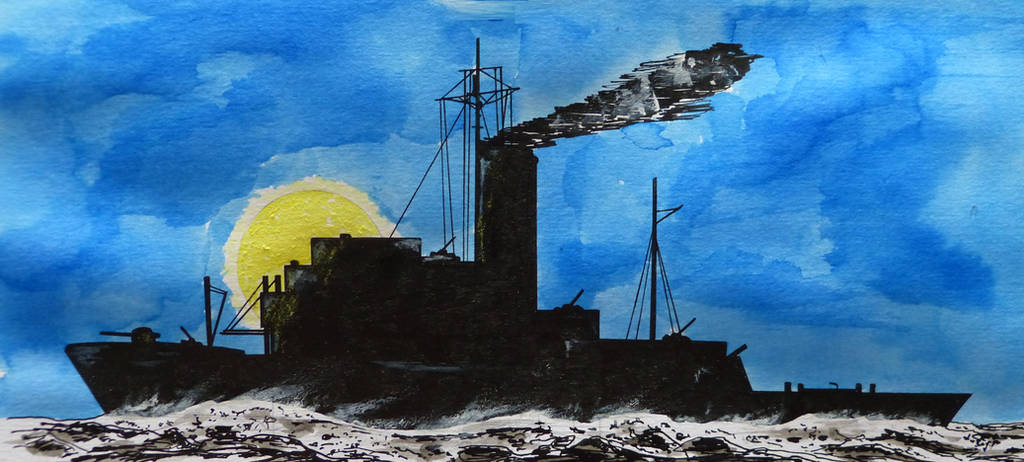Between 1940 and 1945 were the Netherlands occupied by Germany. One of the results was that Dutch shipyards were forced to work for the German government. This work consisted of repairs or rebuilding of ships, new building of warships or auxiliary ships and/or delivering engines, boilers and weapon systems. The Kon.Mij. De Schelde had for instance to built torpedo boats, destroyers, minesweepers and two Kriegssperrbrechers. Strangely enough she was not ordered to built submarines despite her experience and knowledge in the years before the Second World War. She was one of the two major Dutch shipyards building submarines and even built the first Dutch submarine ever.
The main purpose of a so-called sperrbrecher was to create safe passages through minefields for other ships to be used. For detonating magnetic mines they were fitted out with a kind of magnetic field generator.
There are yet none technical specifications and/or drawings traced dealing with the building of this Dutch-built sperrbrechers. On 31 May 1944 wrote the Oberwerftstab of the Kriegsmarine at Zeist, Netherlands that the two ships were to be named KSB 7 and 8. In the order for the building dated 24 August was the amount of ƒ 5.200.000,00 for two ships mentioned. The yardnumbers were 258 and 259. If there was a third ship to be built at Vlissingen was this to be named KSB9.
The Dutch shipyard N.V. C. van der Giesen&Zonen’s Scheepswerven. Krimpen a/d IJssel, Netherlands was in fact the main contractor for the ships, the firm Werkspoor at Amsterdam, Netherlands for the engines and boilers and the firm Firma Rietspoor&Houwens at Rotterdam, Netherlands for the electronic parts. On 5 May 1944 wrote C. van der Giessen in a letter at the Oberwerftstab Verwaltungsabteiling that the boilers and the main and auxiliary engines were ordered at the pre shipyard the Stettiner Oderwerken. What the relation with Werkspoor was, was not mentioned in this letter. A calculation of the building costs referring to a not [preserved letter dated 1 May confirmed that the boilers, engines and dynamo’s were to be delivered by German firms for an amount of ƒ 766.900,00. Werkspoor asked ƒ 1.086.000,00 for the complete enginery equipment including the above mentioned ƒ 766.900,00, including ƒ 7.500 for drawings and 6% profit.
The KSB7 was to be laid down on 1 October 1944, launched on 15 June 1945 and completed on 15 September 1945. For the KSB 8 were the corresponding dates respectively 1 October 1944, 14 July 1945 and 15 October 1945. According to a letter of Van der Giessen dated 23 June was mentioned as date of delivery 15 September and 15 October, put in pencil written were the dated 1 November and 1 December given. For the other Dutch shipyards which had to built this kind of vessels were the dates: Gusto (2) 15 November and 31 December 1945, Boele’s Scheepswerven (1) 15 December 1945 and Van der Giessen (3) 1 September, 1 November and 31 December 1945. The total range of 8 sperrbrechers was named KSB 5-12.
A yet unknown account of a meeting between Dutch shipyards and the German Oberwertstab at Zeist dated 14 February 1944 reveals that the De Schelde was to built 4 sperrbrechers to deliver before the end of 1945 with the Stettiner Oberwerke acting as pre shipyard. For each ship were 400.000 men hours and for the engines 100.000 man hours calculated. The single screw ships were to fitted out with just one machinery similar to the minesweepers of the M 35 design. For each ship was 925 tons of material needed, with castings 1.090 ton. For pipelines was 50 ton material needed. Partly weld and partly riveted. The first part of the building material was already and would be delivered in May-June.
Source
Archive Kon.Mij. De Schelde 1875-1970 (T214) inv.nrs. 658 en 1274 (Municipality archive Vlissingen, Netherlands).

